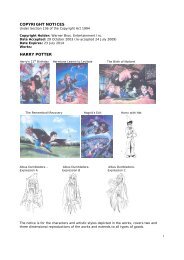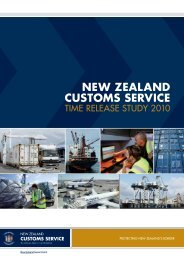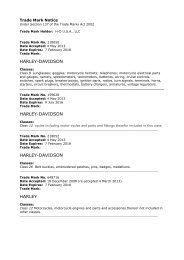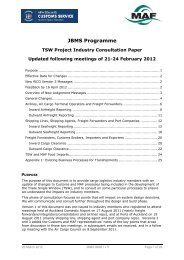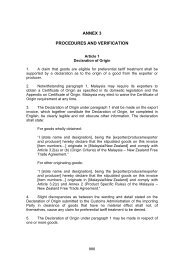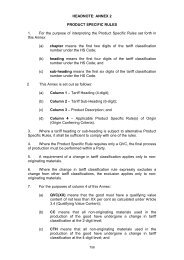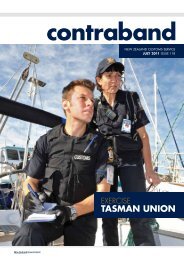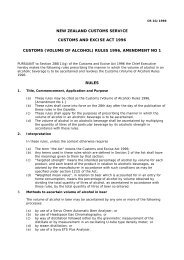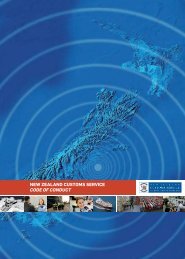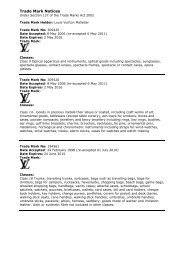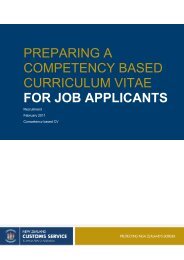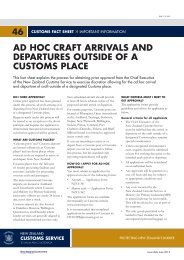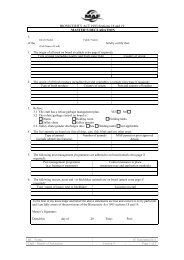Annual Report 2005-2006 - New Zealand Customs Service
Annual Report 2005-2006 - New Zealand Customs Service
Annual Report 2005-2006 - New Zealand Customs Service
Create successful ePaper yourself
Turn your PDF publications into a flip-book with our unique Google optimized e-Paper software.
Performance Measurement Model<br />
INPUTS<br />
Are applied<br />
through a<br />
TRANSFORMATION That<br />
In order<br />
PROCESS delivers OUTPUTS to achieve OUTCOMES<br />
Resources<br />
Capability<br />
&<br />
Capacity<br />
Strategies<br />
Processes<br />
&<br />
Activities<br />
Outputs<br />
Border<br />
Assurance<br />
Outcomes<br />
Outcomes<br />
for the<br />
Community<br />
The ongoing development of the<br />
performance measurement system<br />
will be a priority in <strong>2006</strong>/07<br />
and beyond. This will encompass<br />
the use of direct measurement<br />
and evaluative activity to help<br />
build a comprehensive picture<br />
of performance, impact,<br />
and cost-effectiveness.<br />
Evaluative Activity<br />
<strong>Customs</strong> has undertaken a<br />
range of evaluative activity that is<br />
informing decision-making at both<br />
strategic and operational levels.<br />
Participation in Exercises<br />
<strong>Customs</strong>’ participation in<br />
multi-agency exercises provides<br />
the opportunity for evaluative<br />
activity that enhances <strong>Customs</strong>’<br />
ability to respond to a range of<br />
risks. Recent exercises have<br />
included simulated responses to<br />
mass illegal migration, pandemic<br />
outbreaks, and the proliferation<br />
of strategic goods. Lessons from<br />
multi-agency exercises highlighted<br />
a requirement for a sophisticated<br />
coordination capability.<br />
This was achieved with the<br />
establishment of an Operations<br />
Coordination Unit in December<br />
<strong>2005</strong>. Operations Coordination<br />
is now tasked with developing<br />
a comprehensive “lessons<br />
learnt” process that will capture<br />
the continuous improvements<br />
from operations and exercises<br />
in a structured process.<br />
Evaluation of Trade Security Strategy<br />
The post-implementation<br />
review of <strong>Customs</strong>’ trade security<br />
capability funding found that<br />
trade security standards had<br />
been successfully integrated into<br />
existing trade assurance regimes,<br />
and in voluntary arrangements with<br />
exporters, to reduce the overall<br />
cost and disruption to the trading<br />
sector. This finding confirmed that<br />
the trade security strategy is a<br />
suitable model for wider application.<br />
<strong>Customs</strong> is now focusing on the<br />
trade security standards developed<br />
by the WCO and is exploring the<br />
benefits of bilateral trade security<br />
agreements with <strong>New</strong> <strong>Zealand</strong>’s<br />
other major trading partners.<br />
Evaluation of Enhanced<br />
Inspection Capability<br />
<strong>Customs</strong> received additional<br />
funding in the 2004/05 Budget to<br />
implement enhanced inspection<br />
capabilities as a key pillar of<br />
the Trade Security Strategy.<br />
The effectiveness of the alignment<br />
of the enhanced inspection<br />
resources and capability was<br />
evaluated in <strong>2005</strong>/06. A key<br />
outcome of the evaluation has been<br />
an increased emphasis on forward<br />
planning of inspections to enable<br />
better resource utilisation. The review<br />
also highlighted a need for ongoing<br />
evaluation of the non-invasive<br />
inspection capability including<br />
its appropriateness, its operation,<br />
and where it is deployed.<br />
The latter evaluation identified<br />
existing practices that required<br />
ongoing enhancement as staff<br />
become more proficient in the use<br />
of the equipment. It also found that<br />
the business case assumptions<br />
concerning the placement of the<br />
mobile X-ray trucks still stand true,<br />
and that the mobility of this capability<br />
will enable the intervention rate to be<br />
maintained by moving the equipment<br />
to address identified risk. However<br />
it also noted that the placement of<br />
the equipment should be continually<br />
examined in light of changing<br />
cargo flows and shipping routes to<br />
ensure coverage is maintained.<br />
Risk Management<br />
Risk Management is embedded<br />
across <strong>Customs</strong> as “business<br />
as usual”. An example of this is<br />
the risk-based trade assurance<br />
compliance programme.<br />
An important component of risk<br />
management is the maintenance of a<br />
risk profile to identify the high level risks<br />
that might prevent the <strong>Service</strong> from<br />
achieving its vision, outcomes, and<br />
objectives. The risk profile helps ensure<br />
that mitigation strategies and plans are<br />
in place for the key risks identified.<br />
During the year, strategic and<br />
operational risks were reviewed<br />
and reassessed. The risk profile<br />
identified and ranked strategic<br />
and operational risks and provided<br />
input into planning and reporting<br />
processes and the SOI.<br />
22 <strong>New</strong> <strong>Zealand</strong> <strong>Customs</strong> <strong>Service</strong> – A N N U A L R E P O R T 2 0 0 5 – 2 0 0 6



